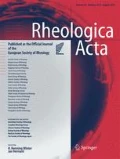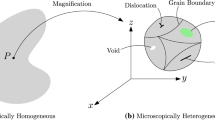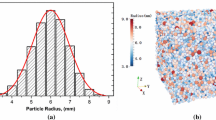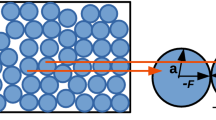Abstract
Macroscopic models for the uniaxial consolidation of strong colloidal gels typically characterise the compressive strength of the particulate network in terms of the compressive yield stress Py(ϕ) or uniaxial elastic modulus K ′ (ϕ). Almost all industrial applications involve multi-dimensional (MD) configurations with arbitrary tensorial stress states, and it is unclear how to generalise these 1D constitutive models to MD consolidation. Several studies have attempted to extend these 1D constitutive models to MD by assuming either isotropic consolidation or zero Poisson’s ratio, but the validity of these assumptions is currently unknown. Lacking is a validated tensorial rheology for the consolidation of strong colloidal gels that is capable of predicting the consolidation of these materials. One step toward the development of such tensorial rheology is the consideration of normal stress differences (NSDs) during uniaxial consolidation. Thus, a tensorial constitutive model for the consolidation of colloidal gels cannot be developed without accounting for these NSDs. We address this problem by performing discrete element model (DEM) simulations of the uniaxial consolidation of a two-dimensional (2D) strong colloidal gel and investigate evolution of the tensorial stress state during consolidation. We show that during consolidation, the Poisson ratio increases from zero near the gel point to almost unity near close-packing and uncover the particle-scale mechanisms that underpin these observations. These results provide the first steps toward a complete tensorial rheology of colloidal gels that is capable of resolving the evolution of these complex materials under superposed differential compression and shear.
Graphical abstract











Similar content being viewed by others
Data availability
Not applicable.
References
Bennett KC (2020) An energy approach to modified cam-clay plasticity and damage modeling of cohesive soils. Acta Geotech 15:165–177. https://doi.org/10.1007/s11440-019-00880-0
Bolintineanu DS, Grest GS, Lechman JB, Pierce F, Plimpton SJ, Schunk PR (2014) Particle dynamics modeling methods for colloid suspensions. Computational Particle Mechanics 1:321–356. https://doi.org/10.1007/s40571-014-0007-6
Boyer F, Guazzelli É, Pouliquen O (2011) Unifying Suspension and Granular Rheology. Phys Rev Lett 107:188301. https://doi.org/10.1103/.PhysRevLett.107.188301
Brady JF, Morris JF (1997) Microstructure of strongly sheared suspensions and its impact on rheology and diffusion. J Fluid Mech 348:103–139. https://doi.org/10.1017/S0022112097006320
Brambilla G, Buzzaccaro S, Piazza R, Berthier L, Cipelletti L (2011) Highly nonlinear dynamics in a slowly sedimenting colloidal gel. Phys Rev Lett 106:118302. https://doi.org/10.1103/PhysRevLett.106.118302
Brown LA, Zukoski CF, White LR (2002) Consolidation during drying of aggregated suspensions. AICHE J 48:492–502. https://doi.org/10.1002/aic.690480308
Bürger R, Concha F (1998) Mathematical model and numerical simulation of the settling of flocculated suspensions. Int J Multiphase Flow 24:1005–1023. https://doi.org/10.1016/S0301-9322(98)00026-3
Buscall R (1982) The elastic properties of structured dispersions: a simple centrifuge method of examination. Colloids Surf A Physicochem Eng Asp 5:269–283. https://doi.org/10.1016/0166-6622(82)80040-1
Buscall R (2009) The relationship between the compressional and shear strengths of poroelastic colloidal gels arXiv preprint arXiv:09030970
Buscall R, White LR (1987) The consolidation of concentrated suspensions. Part 1.—the theory of sedimentation. J Chem Soc, Faraday Trans 1 83:873–891. https://doi.org/10.1039/F19878300873
Buscall R, Mills PDA, Goodwin JW, Lawson DW (1988) Scaling behaviour of the rheology of aggregate networks formed from colloidal particles. J Chem Soc, Faraday Trans 1 84:4249–4260. https://doi.org/10.1039/F19888404249
Channell GM, Zukoski CF (1997) Shear and compressive rheology of aggregated alumina suspensions. AICHE J 43:1700–1708
Channell G, Miller K, Zukoski C (2000) Effects of microstructure on the compressive yield stress. AIChE J 46:72–78. https://doi.org/10.1002/aic.690460110
Cundall PA, Stack ODL (1979) Discrete numerical model for granular assemblies. Geotechnique 29:47–65. https://doi.org/10.1016/0148-9062(79)91211-7
Dixon DC (1977) Momentum-balance aspects of free-settling theory. I. Batch Thickening. Sep Sci 12:171–191. https://doi.org/10.1080/00372367708058069
Fitch B (1983) Kynch theory and compression zones. AICHE J 29:940–947. https://doi.org/10.1002/aic.690290611
Foss DR, Brady JF (2000) Structure, diffusion and rheology of Brownian suspensions by Stokesian dynamics simulation. J Fluid Mech 407:167–200. https://doi.org/10.1017/S0022112099007557
Gilabert FA, Roux JN, Castellanos A (2008) Computer simulation of model cohesive powders: plastic consolidation, structural changes, and elasticity under isotropic loads. Phys Rev E 78:031305. https://doi.org/10.1103/PhysRevE.78.031305
Gladman BR, Rudman M, Scales PJ (2010) Experimental validation of a 1-D continuous thickening model using a pilot column. Chem Eng Sci 65:3937–3946. https://doi.org/10.1016/j.ces.2010.03.029
Hammerich S, Stickland AD, Radel B, Gleiss M, Nirschl H (2019) Modified shear cell for characterization of the rheological behavior of particulate networks under compression. Particuology 51:1–9. https://doi.org/10.1016/j.partic.2019.10.005
Höfgen E, Teo H-E, Scales PJ, Stickland AD (2020) Vane-in-a-filter and vane-under-compressional-loading: novel methods for the characterisation of combined shear and compression. Rheol Acta 59:349–363. https://doi.org/10.1007/s00397-020-01193-w
Howells I, Landman KA, Panjkov A, Sirakoff C, White LR (1990) Time-dependent batch settling of flocculated suspensions. Appl Math Model 14:77–86. https://doi.org/10.1016/0307-904X(90)90075-G
Hsiao LC, Solomon MJ, Whitaker KA, Furst EM (2014) A model colloidal gel for coordinated measurements of force, structure, and rheology. J Rheol 58:1485–1504. https://doi.org/10.1122/1.4884965
Kim C, Liu Y, Kühnle A, Hess S, Viereck S, Danner T, Mahadevan L, Weitz DA (2007) Gravitational stability of suspensions of attractive colloidal particles. Phys Rev Lett 99:028303. https://doi.org/10.1103/PhysRevLett.99.028303
Kloss C, Goniva C (2011) LIGGGHTS – Open Source Discrete Element Simulations of Granular Materials Based on Lammps. In: supplemental proceedings: materials fabrication, properties, characterization, and modeling, vol 2. The minerals, Metals & Materials Society. Doi: https://doi.org/10.1002/9781118062142.ch94
Kloss C, Goniva C, Hager A, Amberger S, Priker S (2012) Models, algorithms and validation for opensource DEM and CFD–DEM Prog Comput. Fluid Dyn 12:140–152
Kobelev V, Schweizer KS (2005) Strain softening, yielding, and shear thinning in glassy colloidal suspensions. Phys Rev E 71:021401
Koumakis N, Moghimi E, Besseling R, Poon WCK, Brady JF, Petekidis G (2015) Tuning colloidal gels by shear. Soft Matter 11:4640–4648. https://doi.org/10.1039/C5SM00411J
Koumakis N, Laurati M, Jacob AR, Mutch KJ, Abdellali A, Schofield AB, Egelhaaf SU, Brady JF, Petekidis G (2016) Start-up shear of concentrated colloidal hard spheres: stresses, dynamics, and structure. J Rheol 60:603–623. https://doi.org/10.1122/1.4949340
Kumar A, Stickland AD, Scales PJ (2012) Viscoelasticity of coagulated alumina suspensions. Korea- Aust Rheol J 24:105–111
Landman KA, Sirakoff C, White LR (1991) Dewatering of flocculated suspensions by pressure filtration. Phys Fluids A 3:1495–1509. https://doi.org/10.1063/1.857986
Landman KA, White LR (1992) Determination of the hindered settling factor for flocculated suspensions. AICHE J 38:184–192. https://doi.org/10.1002/aic.690380203
Landman KA, White LR (1994) Solid/liquid separation of flocculated suspensions. Adv Colloid Interf Sci 51:175–246. https://doi.org/10.1016/0001-8686(94)80036-7
Lee J, Lee SJ, Ahn KH, Lee SJ (2015) Bimodal colloid gels of highly size-asymmetric particles. Phys Rev E 92:012313. https://doi.org/10.1103/PhysRevE.92.012313
Lester DR, Buscall R (2015) Correction of wall adhesion effects in batch settling of strong colloidal gels. J Non-Newtonian Fluid Mech 221:18–27. https://doi.org/10.1016/j.jnnfm.2015.03.006
Lester DR, Usher SP, Scales PJ (2005) Estimation of the hindered settling function R(ϕ) from batch-settling tests. AICHE J 51:1158–1168. https://doi.org/10.1002/aic.10333
Lester DR, Rudman M, Scales PJ (2010) Macroscopic dynamics of flocculated colloidal suspensions. Chem Eng Sci 65:6362–6378. https://doi.org/10.1016/j.ces.2010.09.006
Lester DR, Buscall R, Stickland AD, Scales PJ (2014) Wall adhesion and constitutive modeling of strong colloidal gels. J Rheol 58:1247–1276. https://doi.org/10.1122/1.4891873
Lewis JA (2000) Colloidal processing of ceramics. J Am Ceram Soc 83:2341–2359. https://doi.org/10.1111/j.1151-2916.2000.tb01560.x
Li R, Lester DR (2020) Hierarchical jamming in frictional particle assemblies ArXiV XXX
Liétor-Santos J, Kim C, Lu P, Fernández-Nieves A, Weitz D (2009) Gravitational compression of colloidal gels. Eur Phys J E Soft Matter 28:159–164. https://doi.org/10.1140/epje/i2008-10390-7
Lin NYC, Guy BM, Hermes M, Ness C, Sun J, Poon WCK, Cohen I (2015) Hydrodynamic and contact contributions to continuous shear thickening in colloidal suspensions. Phys Rev Lett 115:228304. https://doi.org/10.1103/PhysRevLett.115.228304
Luding S (2016) So much for the jamming point. Nat Phys 12:531–532. https://doi.org/10.1038/nphys3680
Madeline JB, Meireles M, Bourgerette C, Botet R, Schweins R, Cabane B (2007) Restructuring of colloidal cakes during dewatering. Langmuir 23:1645–1658. https://doi.org/10.1021/la062520z
Manley S, Skotheim JM, Mahadevan L, Weitz DA (2005) Gravitational collapse of colloidal gels. Phys Rev Lett 94:218302. https://doi.org/10.1103/PhysRevLett.94.218302
Marenne S, Morris JF, Foss DR, Brady JF (2017) Unsteady shear flows of colloidal hard-sphere suspensions by dynamic simulation. J Rheol 61:477–501. https://doi.org/10.1122/1.4979005
Michaels AS, Bolger JC (1962) Settling rates and sediment volumes of flocculated kaolin suspensions. Ind Eng Chem Fundam 1:24–33. https://doi.org/10.1021/i160001a004
Mihai LA, Goriely A (2017) How to characterize a nonlinear elastic material? A review on nonlinear constitutive parameters in isotropic finite elasticity Proceedings of the Royal Society A: Mathematical, Physical and Engineering Sciences 473:20170607 doi:https://doi.org/10.1098/rspa.2017.0607
Miller KT, Melant RM, Zukoski CF (1996) Comparison of the compressive yield response of aggregated suspensions: pressure filtration, centrifugation, and osmotic consolidation. J Am Ceram Soc 79:2545–2556. https://doi.org/10.1111/j.1151-2916.1996.tb09014.x
Parneix C, Persello J, Cabane B, Schweins R (2009) How do colloidal aggregates yield to compressive stress? Langmuir 25:4692–4707. https://doi.org/10.1021/la803627z
Perrin H, Clavaud C, Wyart M, Metzger B, Forterre Y (2019) Interparticle friction leads to nonmonotonic flow curves and hysteresis in viscous suspensions. Phys Rev X 9:031027
Philip JR, Smiles DE (1982) Macroscopic analysis of the behavior of colloidal suspensions. Adv Colloid Interf Sci 17:83–103. https://doi.org/10.1016/0001-8686(82)80013-4
Roy S, Tirumkudulu MS (2016a) Universality in consolidation of colloidal gels. Soft Matter 12:9402–9406. https://doi.org/10.1039/c6sm02175a
Roy S, Tirumkudulu MS (2016b) Yielding in a strongly aggregated colloidal gel. Part I: 2D simulations. J Rheol 60:559–574. https://doi.org/10.1122/1.4948324
Roy S, Tirumkudulu MS (2016c) Yielding in a strongly aggregated colloidal gel. Part II: Theory. J Rheol 60:575–586. https://doi.org/10.1122/1.4948325
Roy S, Tirumkudulu MS (2020) Micro-mechanical theory of shear yield stress for strongly flocculated colloidal gel. Soft Matter 16:1801–1809. https://doi.org/10.1039/C9SM01784D
Rubasingha SN (2016) Combined shear and compression suspension rheology
Rzepiela A, van Opheusden J, van Vliet T (2004) Large shear deformation of particle gels studied by Brownian dynamics simulations. J Rheol 48:863–880
Seto R, Botet R, Meireles M, Auernhammer GK, Cabane B (2013a) Compressive consolidation of strongly aggregated particle gels. J Rheol 57:1347–1366. https://doi.org/10.1122/1.4817436
Seto R, Mari R, Morris JF, Denn MM (2013b) Discontinuous shear thickening of frictional hard-sphere suspensions. Phys Rev Lett 111:218301. https://doi.org/10.1103/PhysRevLett.111.218301
Sierou A, Brady JF (2002) Rheology and microstructure in concentrated noncolloidal suspensions. J Rheol 46:1031–1056. https://doi.org/10.1122/1.1501925
Stickland AD (2012) A compressional rheology model of fluctuating feed concentration during filtration of compressible suspensions. Chem Eng Sci 75:209–219
Stickland AD, Buscall R (2009) Whither compressional rheology? J Non-Newtonian Fluid Mech 157:151–157. https://doi.org/10.1016/j.jnnfm.2008.11.006
Uhlherr PHT, Guo J, Tiu C, Zhang XM, Zhou JZQ, Fang TN (2005) The shear-induced solid–liquid transition in yield stress materials with chemically different structures. J Non-Newtonian Fluid Mech 125:101–119. https://doi.org/10.1016/j.jnnfm.2004.09.009
Wang M, Brady JF (2015) Constant Stress and Pressure Rheology of Colloidal Suspensions. Phys Rev Lett 115:158301. https://doi.org/10.1103/PhysRevLett.115.158301
Acknowledgements
The authors would like to acknowledge the RMIT University and CSIRO Mineral Resources for financial support and the support of the NCI (National Computational Infrastructure) for high-performance computing resources.
Author information
Authors and Affiliations
Corresponding author
Ethics declarations
Conflict of interest
The authors declare that they have no conflicts of interest.
Code availability
The open-source DEM software LIGGGHTS used throughout this article is available at the website https://www.cfdem.com/download-liggghtsr-public.
Additional information
Publisher’s note
Springer Nature remains neutral with regard to jurisdictional claims in published maps and institutional affiliations.
Appendix 1: Extension of particle-scale theory to non-uniform particle contact angle distributions
Appendix 1: Extension of particle-scale theory to non-uniform particle contact angle distributions
To explore whether the assumption of uniform contact angle distribution used in the RT theory is responsible for this failure, we consider the evolving force-weighted contact angle distribution Ef(θ, ϕ) that evolves with solids concentration shown in Fig. 6. We approximate this distribution of contact angles by the exponential decay function:
where the characteristic contact angle λ(ϕ) evolves linearly with solids concentration as:
where θg = 0.005 and θcp = 2.00 respectively are the characteristic contact angles at the gel point (Fig. 6a) and close-packing (Fig. 6b) concentrations.
We extend the particle-scale theory of Roy and Tirumkudulu (RT) (Roy and Tirumkudulu 2016c) to non-uniform particle contact angle distributions. RT derive the following expression for the components of the particle-scale average stress tensor by considering the pressure and traction forces acting between two particles as shown in Fig. 1.
where E[θ, ϕ] is the particle contact angle distribution, P is the interparticle pressure, Ti is the interparticle torque, ni is the normal vector between the particles and 〈z(ϕ)〉 is the mean coordination number. Whilst RT consider a uniform particle distribution E[θ, ϕ] = 2/π, we relax this assumption and consider the evolving force-weighted distribution given by Eqs. (19) and (20). RT divide the integral in Eq. (21) into two regions for the elastic (0 < θ < θr) and plastic (θr < θ < π/2) components of the sliding friction as:
The total strain σii is then decomposed into the elastic \( {\sigma}_{\mathrm{ii}}^e \) and plastic \( {\sigma}_{\mathrm{ii}}^p \) components
The transition from elastic to plastic deformation occurs when the applied strain eo exceeds a critical value ec which RT (Roy and Tirumkudulu 2016c) derive as
Equations (23–25) then form the basis for the affine and non-affine particle-scale models for consolidation.
Affine model
The affine model of RT assumes affine deformation at the particle scale, where consolidation occurs in the axial 1-direction and the 2-direction is transverse to the consolidation direction. Under the assumption of uniform contact angle distribution (E[θ, ϕ] = 2/π), Eqs. (23–25) yield a constant value for the normalised NSD as given by Eq. (14). To relax this assumption, we inset the model Eq. (19) for the force-weighted particle contact distribution into Eq. (23), yielding the following expressions for the normal stresses:
The normalised NSD \( {N}_1^{\ast } \) can then be calculated from these normal stresses as
As shown in Fig. 11a, this model predicts a reduction of the relative NSD with solid concentration; however, this reduction is only very minor for the parameter values of the DEM simulation.
Non-affine model
Similarly, the non-affine RT model may be extended to non-uniform contact angle distributions as follows. The non-affine model of RT has been developed based on the assumption of non-affine deformation at the particle scale. The normalised NSD as given by Eq. (18) yield an increasing behaviour with solids concentration under the assumption of uniform contact angle distribution (E[θ, ϕ] = 2/π). To facilitate the prediction of normalised NSD as observed in Fig. 8b, we reproduce a non-affine model of RT for the force-weighted particle contact distribution into Eq. (23) that yields the following expressions for the normal stresses:
These normal stresses of Eq. (29) and Eq. (30) then yields the following expression for the normalised NSD as
This model also yields only a minor reduction of the relative NSD with solids concentration for the parameter values of the DEM simulation (in Fig. 11b). These results indicate that even when non-uniform force-weighted contact angle distribution is accounted for, the affine and non-affine variants of the RT theory cannot resolve the evolution of NSDs under uniaxial consolidation. For the affine RT model, the maximum reduction of the relative NSD occurs in the case of negligible transverse elastic modulus (k = 0), such that the contact angle distribution evolves from the Dirichlet function Ef(θ, ϕg) = δ(θ) at the gel point to the uniform distribution Ef(θ, ϕcp) = 1/2π near close-packing and the relative NSD decays from \( {N}_1^{\ast } \)=1 at ϕ = ϕg to \( {N}_1^{\ast }=2/3 \) at ϕ = ϕcp. As shown by Fig. 8, we observe a decrease of the normalised NSD to \( {N}_1^{\ast}\approx 0.27 \), well beyond the theoretical limit of 2/3 suggested by the affine theory. Conversely, the normalised NSD always increases with solids concentration in the non-affine RT model due to the nonlinear contribution of the fractal terms in the model (under the geometric constraint df < d), regardless of how the contact angle distribution evolves with concentration.
We attribute the inherently affine nature of the micro-mechanical theory (Roy and Tirumkudulu 2016c) to the inability to resolve the evolution of NSDs under uniaxial consolidation. In the “Simulation results” section, we showed that buckling, collapse and strain hardening of columnar structures oriented in the axial direction play a key role in the evolution of the axial and transverse normal stresses, and these dynamics are not resolved by the two-particle affine model.
Rights and permissions
About this article
Cite this article
Islam, M.M., Lester, D.R. Normal stress differences in the consolidation of strong colloidal gels. Rheol Acta 60, 59–76 (2021). https://doi.org/10.1007/s00397-020-01254-0
Received:
Revised:
Accepted:
Published:
Issue Date:
DOI: https://doi.org/10.1007/s00397-020-01254-0





